To ensure durability and safety in metal water bottles, choose high-quality materials like stainless steel or titanium, prioritize safety standards, and inspect for wear and tear regularly. Avoid harsh cleaning agents, practice proper storage techniques, and establish a regular cleaning routine. Check lid and cap seals for integrity, and select bottles with reinforced bottoms or protective coatings for impact resistance. Opt for BPA-free options, double-wall construction, and vacuum insulation to manage extreme temperatures. Seek dishwasher-safe materials for easy maintenance. Remember, proper maintenance and material selection are key to ensuring long-lasting durability and safety.
Key Takeaways
- Choose stainless steel or titanium for durability and safety.
- Verify safety standards and quality control measures.
- Inspect seals regularly for leak prevention.
- Avoid extreme temperatures for longevity.
- Opt for dishwasher-safe options for convenience.
Choose High-Quality Materials
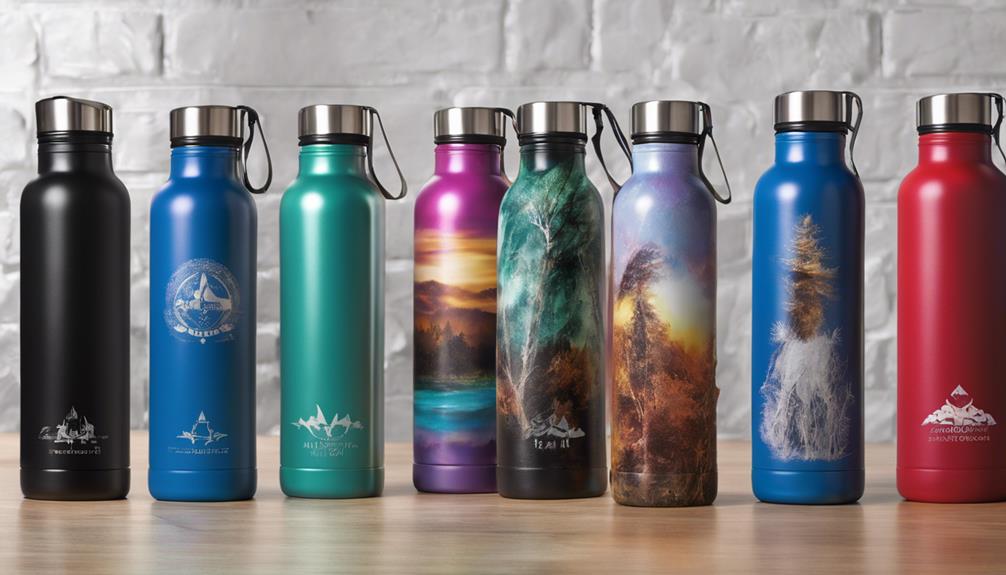
To ensure durability and safety in metal water bottles, opt for materials with exceptional strength and corrosion resistance. Material selection is crucial in determining the longevity and reliability of your water bottle.
When choosing a metal water bottle, consider materials like stainless steel or titanium, known for their durability and resistance to corrosion. These materials undergo rigorous durability testing to ensure they can withstand daily wear and tear without compromising safety.
Additionally, it's essential to prioritize safety standards and quality control measures during the manufacturing process. High-quality materials alone aren't sufficient; adherence to safety regulations and stringent quality control protocols is paramount.
Look for water bottles that meet industry standards for safety and have undergone quality control inspections to guarantee that they're free from defects and potential hazards.
Avoid Harsh Cleaning Agents
Using harsh cleaning agents on metal water bottles can compromise their durability and safety, leading to potential risks for the user. To maintain the integrity of your metal water bottle, it's crucial to opt for gentle cleaning methods using eco-friendly materials.
Here are some tips to help you avoid harsh cleaning agents:
- Use Mild Soap: When cleaning your metal water bottle, opt for a mild soap that's gentle on the material. Avoid harsh chemicals that can corrode the metal or leave residues that may be harmful to your health.
- Baking Soda and Vinegar Solution: For tougher stains or odors, create a natural cleaning solution using baking soda and vinegar. This eco-friendly mixture is effective in removing dirt and grime without damaging the metal.
- Soft Bristle Brush: When scrubbing your metal water bottle, use a soft bristle brush to avoid scratching the surface. Opt for brushes made from eco-friendly materials like bamboo or recycled plastic to ensure a gentle yet thorough cleaning process.
Inspect for Wear and Tear
Regularly examine your metal water bottle for signs of wear and tear to ensure its continued durability and safety. Daily inspection is crucial to catch any early signs of deterioration. Look for scratches, dents, or discoloration on the surface of the bottle, as these can indicate potential weak spots where rust may develop.
Rust prevention is essential to maintaining the integrity of the metal and preventing leaks or contamination of your water. Corrosion control is paramount in ensuring the longevity of your metal water bottle. If you notice any areas where the metal has started to corrode, take immediate action.
Use a mild cleaning solution and a soft brush to gently scrub away any corrosion, then thoroughly dry the bottle to prevent further damage.
Proper Storage Practices
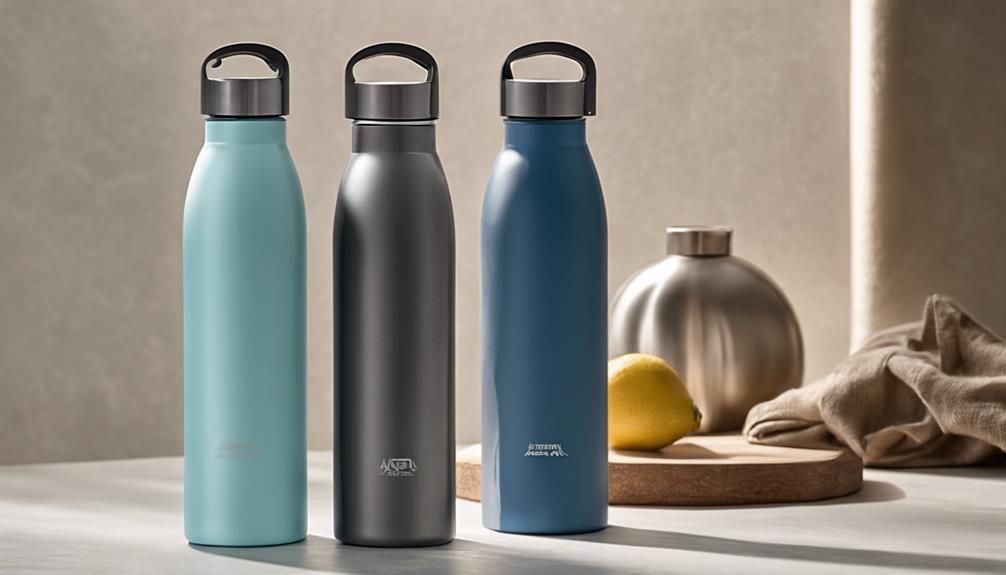
Implement a systematic approach to storing your metal water bottle to maintain its quality and safety over time. Proper storage practices are essential to prevent damage and contamination.
Consider the following tips to ensure the longevity of your metal water bottle:
- Storage Solutions:
Store your metal water bottle in a cool, dry place away from direct sunlight to prevent the growth of bacteria and the breakdown of materials. Avoid storing it near chemicals or sharp objects that could cause dents or scratches.
- Maintenance Tips:
Regularly check for any signs of wear and tear, such as dents, scratches, or chipped paint, and address them promptly to prevent further damage. Keep the bottle clean by washing it with warm, soapy water and allowing it to air dry completely before storing it.
- Preventing Contamination & Organization Hacks:
Use separate storage compartments or pouches to keep your metal water bottle away from other items to prevent cross-contamination. Consider using hooks or racks to organize your bottles efficiently and prevent them from getting damaged in cluttered spaces.
Regular Cleaning Routine
To maintain the durability and safety of your metal water bottle, it's crucial to establish a regular cleaning routine. Proper cleaning techniques, such as using mild soap and a bottle brush, are essential for keeping your bottle free from bacteria and odors.
Ensuring you clean your bottle at least once a day and using safe materials for cleaning will help you maintain a hygienic and long-lasting water bottle.
Proper Cleaning Techniques
Ensure the metal water bottle is thoroughly cleaned after each use to maintain its durability and safety. Proper cleaning techniques are crucial to prevent the buildup of harmful bacteria and extend the lifespan of your bottle.
Follow these steps for an effective cleaning routine:
- Use Eco-Friendly Alternatives: Opt for natural cleaning solutions like a mixture of vinegar and water or baking soda. These eco-friendly options are gentle on the environment and safe for your health.
- Deep Cleaning Methods: Periodically perform a deep clean by soaking the bottle in a solution of warm water and dish soap. Use a bottle brush to scrub the interior and reach all crevices. Rinse thoroughly to ensure no soap residue remains.
- Sanitizing: To sanitize your bottle, consider using a diluted bleach solution or specialized bottle sanitizing tablets. Follow the manufacturer's instructions carefully to maintain the bottle's integrity while effectively killing germs. Remember to rinse the bottle thoroughly after sanitizing to remove any remaining chemicals.
Frequency of Cleaning
Maintaining a consistent cleaning schedule for your metal water bottle is key to preserving its durability and safety. Cleaning frequency directly impacts the growth of harmful bacteria within the bottle. Regular cleaning, at least once a day, is recommended to prevent bacterial buildup, which can compromise the safety of the water you consume.
Neglecting to clean your bottle regularly can lead to the formation of biofilms, which are communities of bacteria that adhere to the bottle's interior surface. These biofilms not only affect the taste of the water but also pose health risks.
In addition to safeguarding against bacteria growth, frequent cleaning also plays a role in maintaining the durability and impact resistance of your metal water bottle. Residues left inside the bottle can react with the metal, potentially causing corrosion over time. This corrosion weakens the structural integrity of the bottle, making it more susceptible to dents and leaks.
Use of Safe Materials
Regularly cleaning your metal water bottle with safe materials is essential for maintaining its durability and safety. To ensure the materials used in your bottle meet safety standards, consider the following:
- Material Testing: Opt for metal water bottles that have undergone rigorous material testing to ensure they're free from harmful substances like BPA, lead, or phthalates. Look for bottles that specify being food-grade stainless steel or aluminum, as these are generally safe choices.
- Safety Certifications: Check for safety certifications such as FDA approval or NSF International certification, which indicate that the bottle has met specific safety requirements. These certifications provide assurance that the materials used in the bottle are safe for holding water.
- Product Labeling: Pay attention to product labeling that discloses information about the bottle's materials and coatings. Avoid bottles with vague or misleading labels, and prioritize those with clear information about the environmental impact of the materials used.
Check for Leaks and Seals
Inspect the metal water bottle carefully for any signs of leaks or compromised seals to ensure its integrity and functionality. Properly sealing the bottle is crucial for leak prevention and maintaining the safety of its contents. Begin by examining the seams and joints where the bottle components meet. Look for any visible cracks, gaps, or irregularities that could indicate a potential leak. Additionally, check the lid and cap seals to ensure they're intact and secure.
To further verify the bottle's durability and safety, conduct seal inspection tests. Fill the bottle with water and tighten the lid securely. Tilt the bottle in different directions and observe for any leaks or drips. You can also gently squeeze the bottle to apply pressure and check if the seals hold up.
Regularly inspecting and testing the seals of your metal water bottle is essential for preventing leaks and ensuring its reliability during everyday use. By being proactive in checking for any potential issues, you can maintain the integrity and safety of your water bottle.
Avoid Extreme Temperatures
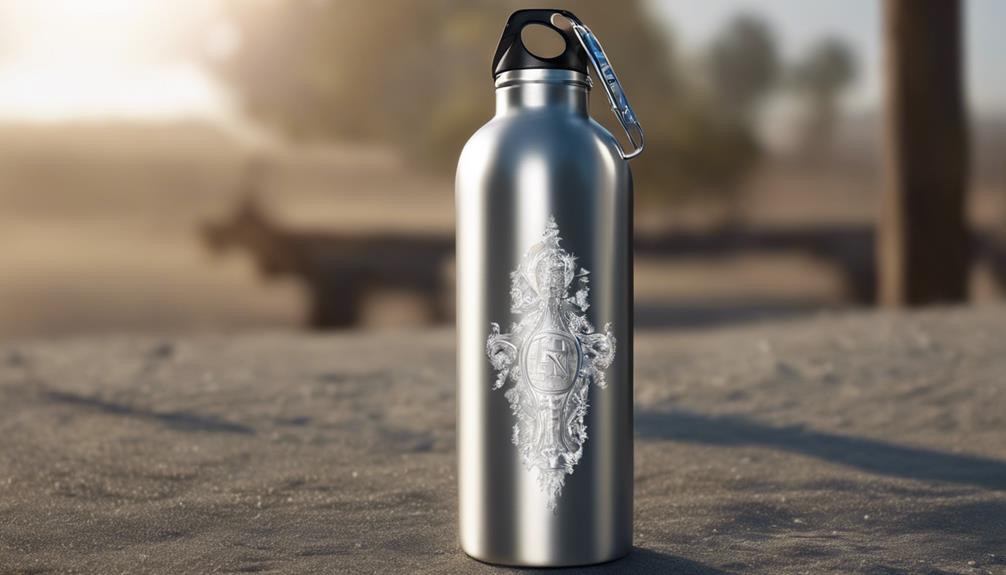
To preserve the integrity and safety of your metal water bottle, it's crucial to avoid exposing it to extreme temperatures that could compromise its structural strength and insulation properties. Extreme temperatures can have detrimental effects on the overall performance and longevity of your bottle.
Here are some key considerations to keep in mind:
- Insulation Effectiveness: Extreme temperatures can impact the insulation properties of your metal water bottle. Sudden changes in temperature can cause the material to expand or contract, affecting its ability to retain hot or cold liquids effectively.
- Design Considerations: The design of your metal water bottle plays a significant role in its ability to withstand extreme temperatures. Look for bottles with double-wall construction and vacuum insulation to help maintain temperature retention.
- Temperature Retention and Impact Resistance Testing: Manufacturers often conduct rigorous testing to ensure that metal water bottles can retain temperatures effectively and withstand impact. Make sure to check if your bottle has undergone such testing to guarantee its durability in varying conditions.
Use BPA-Free Options
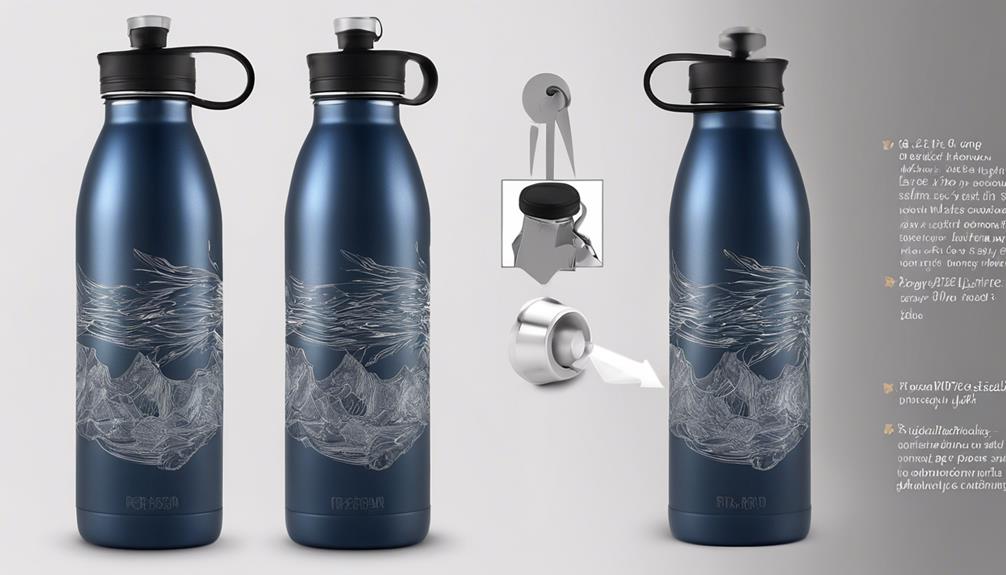
When selecting a metal water bottle, prioritize options that are BPA-free to ensure a safer and healthier drinking experience. BPA, a chemical often found in plastics, can leach into liquids when exposed to heat or other factors, potentially leading to health implications. Opting for BPA-free metal water bottles not only eliminates this risk but also contributes to eco-friendly alternatives. Sustainable manufacturing processes ensure that these bottles are produced with minimal environmental impact, aligning with a more conscious lifestyle.
Design considerations play a crucial role in the selection of BPA-free metal water bottles. Look for bottles with durable coatings that are free from harmful chemicals like BPA. Stainless steel options are often a reliable choice due to their resistance to corrosion and ability to maintain the temperature of your drink. Additionally, choose bottles with secure lids and easy-to-clean designs to promote hygiene and convenience.
Consider Impact Resistance
Choose metal water bottles with high impact resistance to ensure durability and long-lasting performance. When considering the impact resistance of a metal water bottle, it's crucial to look for products that meet stringent durability standards.
To gauge a bottle's ability to withstand impact, manufacturers conduct impact resistance testing following safety guidelines.
Here are key factors to consider:
- Material Composition: Opt for bottles made from robust metals like stainless steel, aluminum, or titanium, as they offer superior impact resistance compared to other materials.
- Design Features: Look for bottles with reinforced bottoms or protective coatings to enhance their ability to withstand drops and impacts.
- Certifications: Prioritize bottles that have undergone metal bottle drop tests and comply with safety guidelines set by relevant authorities to ensure they meet stringent durability standards.
Seek Dishwasher-Safe Options
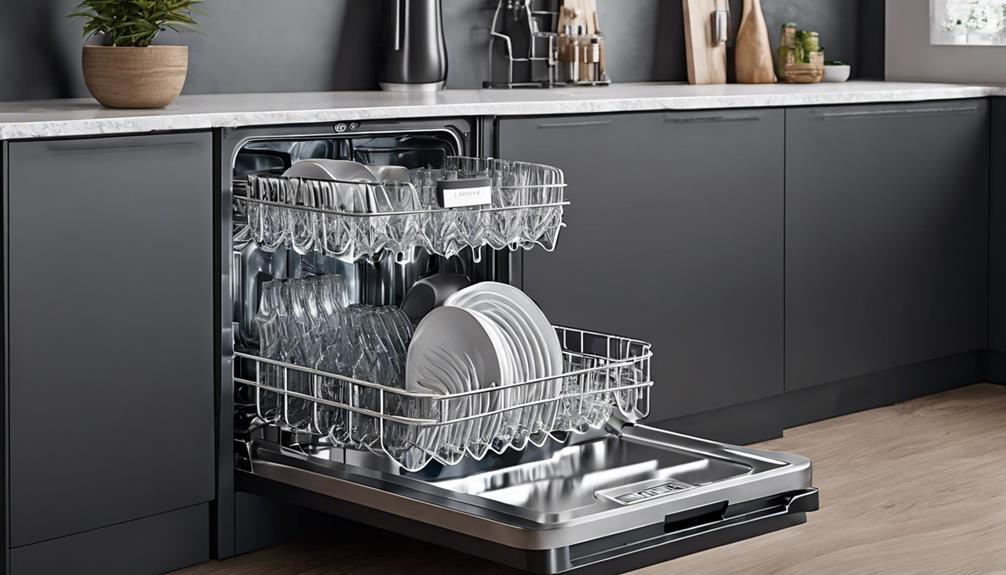
When selecting a metal water bottle, prioritize dishwasher-safe options for cleaning convenience. Opting for materials that are compatible with dishwashers ensures thorough sanitation and easy maintenance.
This feature saves time and effort in maintaining your water bottle's hygiene.
Dishwasher-Safe Materials
Consider opting for metal water bottles made from materials designated as dishwasher-safe to simplify cleaning and maintenance routines.
When selecting dishwasher-safe materials for your water bottle, keep in mind the following factors:
- Material Compatibility: Look for bottles made from stainless steel, aluminum, or titanium as these materials are known for their durability and resistance to high temperatures, making them suitable for dishwasher use.
- Durability: Opting for dishwasher-safe materials ensures that your water bottle can withstand repeated wash cycles without compromising its structural integrity, extending its lifespan and reducing the need for frequent replacements.
- Environmental Impact: Choosing dishwasher-safe materials promotes sustainability by encouraging reuse and reducing the consumption of single-use plastic bottles, thereby contributing to environmental conservation efforts.
Cleaning Convenience Options
Seeking dishwasher-safe options for cleaning your metal water bottle can streamline maintenance routines and ensure efficient hygiene practices. When selecting a metal water bottle, opt for models that are labeled as dishwasher-safe to simplify the cleaning process. This feature allows you to conveniently place your bottle in the dishwasher along with your other dishes for a thorough cleaning cycle.
In addition, consider eco-friendly alternatives to harsh detergents when cleaning your metal water bottle. Look for natural cleaning solutions or biodegradable detergents to minimize environmental impact while maintaining cleanliness. These options are effective in removing residue and odors without compromising the integrity of your bottle or harming the environment.
To enhance the drying process of your metal water bottle after washing, explore quick drying methods such as using a clean towel to wipe the interior and exterior surfaces. This ensures that no moisture is trapped inside the bottle, preventing the growth of bacteria and mold.
Test for Water Purity
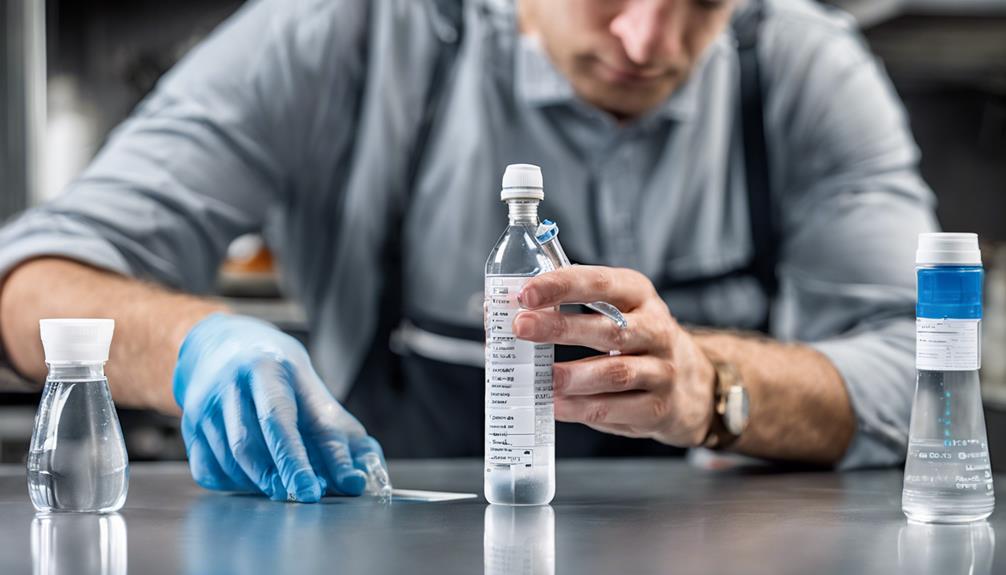
To determine the purity of the water in your metal bottle, conduct a simple test using a water quality testing kit. Ensuring your water is free from contaminants is crucial for maintaining good health.
Follow these steps to test the water purity:
- Collect a Sample:
Take a sample of water from your metal bottle. Make sure the bottle has been thoroughly cleaned to avoid any cross-contamination.
- Use the Testing Kit:
Follow the instructions provided with the water quality testing kit. Typically, these kits contain test trips that change color in the presence of specific contaminants, indicating the water's purity level.
- Interpret the Results:
Compare the color changes on the test strips with the guide provided by the testing kit. This will help you identify any contaminants present in your water, ensuring you can take appropriate action to address the issue.
Frequently Asked Questions
Can Metal Water Bottles Affect the Taste of Water?
When using metal water bottles, the material can impact water purity and taste retention. To maintain water quality, clean bottles regularly with mild soap and avoid storing beverages for extended periods. Proper cleaning methods help preserve taste.
How Often Should I Replace the Seals in My Water Bottle?
You should replace the seals in your water bottle regularly to maintain durability and safety. Typically, seals have a lifespan of 6-12 months, depending on usage. Follow manufacturer guidelines for proper replacement frequency to ensure effectiveness.
Are Metal Water Bottles Safe for Hot Beverages?
When using metal water bottles for hot beverages, ensure proper insulation and temperature retention. This helps maintain the desired drink temperature longer. Be cautious with extremely hot liquids to prevent burns and choose bottles designed for hot drinks.
Can I Use Essential Oils in My Metal Water Bottle?
You should avoid using essential oils in your metal water bottle as they can degrade the materials, potentially causing health risks. To clean your bottle effectively, use mild soap and warm water, avoiding harsh chemicals.
How Do I Remove Stubborn Odors From My Metal Water Bottle?
To remove stubborn odors from your metal water bottle, consider using odor removal techniques like soaking it in a mixture of baking soda and warm water or utilizing a vinegar solution. Regular cleaning methods can also help prevent odors from developing.
Conclusion
In conclusion, by following these steps to ensure durability and safety in metal water bottles, you can be confident in the quality and longevity of your hydration vessel. Remember, proper maintenance and care are essential to maximizing the lifespan of your bottle.
So, take the necessary precautions and enjoy peace of mind knowing that your water bottle is built to last. But remember, there's one crucial test that could make or break your decision...

